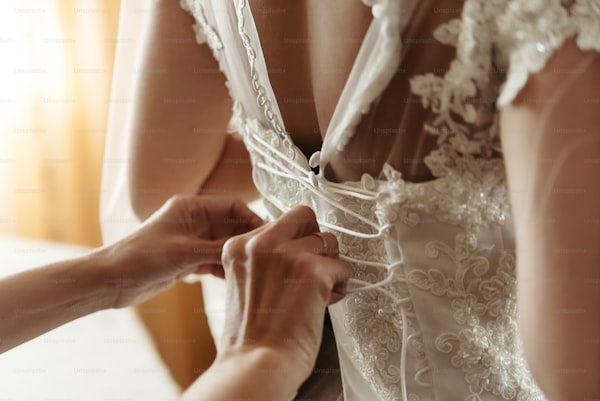Essential Methods to Reinforce Delicate Wedding Dress Fabrics like Chiffon
The Art of Protecting Your Wedding Dress: Reinforcement Techniques for Chiffon
When planning a wedding, every detail matters, especially the wedding dress. Among the fabrics, chiffon stands out for its ethereal beauty and flowing elegance. However, its delicacy raises concerns regarding durability and longevity. This article will explore effective methods to reinforce delicate wedding dress fabrics like chiffon, ensuring your dream dress remains exquisite on your special day and beyond.
Why Reinforce Chiffon Wedding Dresses?
Chiffon is a lightweight, sheer fabric known for its graceful drape and soft texture. While these qualities make it a popular choice for wedding dresses, they also make it susceptible to tears, fraying, and other types of damage. Reinforcement helps maintain the integrity of the fabric, ensuring your dress can withstand the wear and tear of the day. Here are some key reasons to consider reinforcement:
- Longevity: Reinforcing chiffon can help ensure that your dress can be preserved and passed down through generations.
- Ease of Movement: A well-reinforced dress allows for easier movement without the fear of damaging the fabric.
- Aesthetic Appeal: Proper reinforcement can enhance the overall look of the dress, keeping it flouncy and beautiful.
Effective Methods for Reinforcing Chiffon
Now that we understand the importance of reinforcing chiffon, let’s delve into some practical methods.
| Method | Description |
| Interfacing | Applying interfacing can provide structure and support to delicate chiffon areas, particularly where seams or fastenings are involved. |
| Seam Tape | This product can help prevent seams from stretching and fraying, adding durability to critical areas. |
| Lining | Adding a lining to the dress not only enhances comfort but also protects the chiffon from wear. |
| French Seams | Utilizing French seams can encase raw edges to prevent fraying while offering an elegant finish. |
| Beading | Strategically placed beads can add weight and stability to the fabric while elevating the overall aesthetic. |
1. Interfacing
Interfacing is a textile used to stiffen and add structure to fabric. For wedding dresses made of chiffon, lightweight fusible interfacing is ideal. It is applied to specific areas where added support is necessary, such as the bodice or hem. Choose an interfacing that is both breathable and compatible with chiffon for best results. This method is particularly useful for ensuring that delicate areas retain their shape throughout the ceremony.
2. Seam Tape
Seam tape is a fantastic option for reinforcing the seams on a chiffon dress. Simply apply the tape along the seam lines before stitching to keep the fabric from stretching out over time. This is particularly beneficial in high-stress areas where movement occurs, ensuring that the fabric maintains its integrity during wear.
3. Lining
Adding a layer of lining fabric beneath the chiffon can provide an additional barrier against damage while enhancing comfort. Consider using a lightweight silk or satin for this purpose. The lining not only acts as protection but also improves the structure of the gown, giving it a fuller appearance and preventing clinginess.
4. French Seams
French seams are a delicate technique that encases raw edges to prevent fraying. This method is particularly beneficial for chiffon, as it ensures durability and maintains a sleek profile. Although time-consuming, the result is a beautifully finished seam that enhances the dress's aesthetic appeal.
5. Beading
Incorporating beads into the design can serve more than just an aesthetic purpose. The added weight can help stabilize the chiffon fabric, preventing it from moving or shifting awkwardly. Be mindful of the placement; a strategically beaded bodice or hem can enhance the overall design while providing reinforcement where needed.
Tips for Judging the Right Reinforcement Technique
Choosing which reinforcement method to use can depend on various factors, including dress design, fabric weight, and personal preference. Here are some tips to guide your decision:
- Type of Chiffon: Consider whether your chiffon is sheer or heavy; sheer chiffon may require more delicate handling and methods.
- Dress Design: A fitted design may require different reinforcement compared to a flowing A-line gown.
- Comfort: Always prioritize comfort in reinforcement—ensure the methods do not add unnecessary bulk or weight.
Common Concerns and Questions
Brides often have various concerns when it comes to maintaining their chiffon wedding dresses. Here are some frequently asked questions:
1. How Can I Prevent My Chiffon Dress from Stretching?
Using seam tape, interfacing, and lining can help prevent stretching. Additionally, hang the dress instead of folding it, as this can cause stretching over time.
2. Is it Safe to Wash a Chiffon Wedding Dress?
Washing chiffon requires careful attention. It is best to have the dress professionally cleaned, especially if it has delicate embellishments. If washing at home, use cold water and a gentle detergent.
3. Can I Make Alterations Myself?
While DIY alterations may be tempting, chiffon can be tricky to work with. If you're unsure, it is always wise to consult a professional seamstress for assistance.
Conclusion: Protecting Your Precious Chiffon Wedding Dress
Reinforcing delicate wedding dress fabrics like chiffon is essential for ensuring your dress not only looks beautiful but withstands the excitement of your wedding day and beyond. By carefully selecting reinforcement methods such as interfacing, seam tape, and lining, you can maintain the integrity and elegance of your gown. Remember to consider the type of chiffon, dress design, and your own comfort when choosing the best techniques. With these tips and methods, you can walk down the aisle with confidence, knowing your dress will shine and last through the years.
Final Note: Always consult with a professional when in doubt about the best reinforcement practices for your unique gown. Your wedding dress is a cherished piece, and proper care will help it remain a treasured memory for years to come.